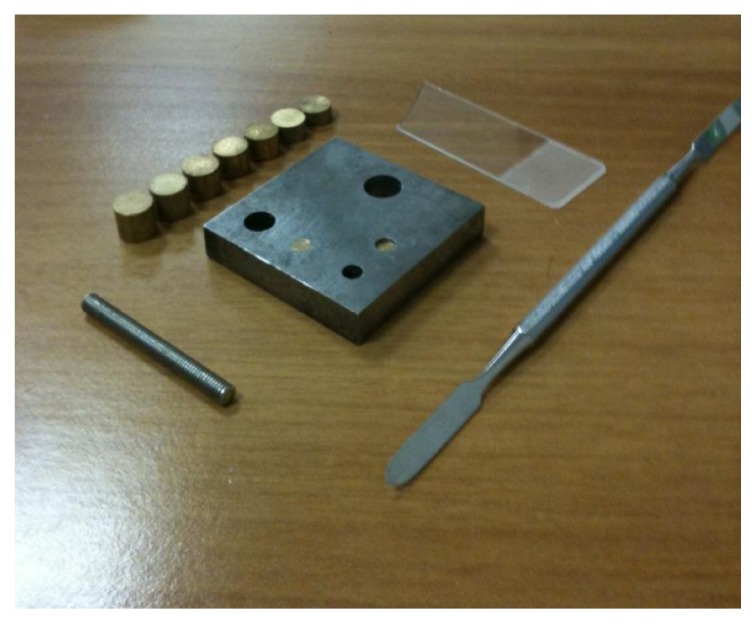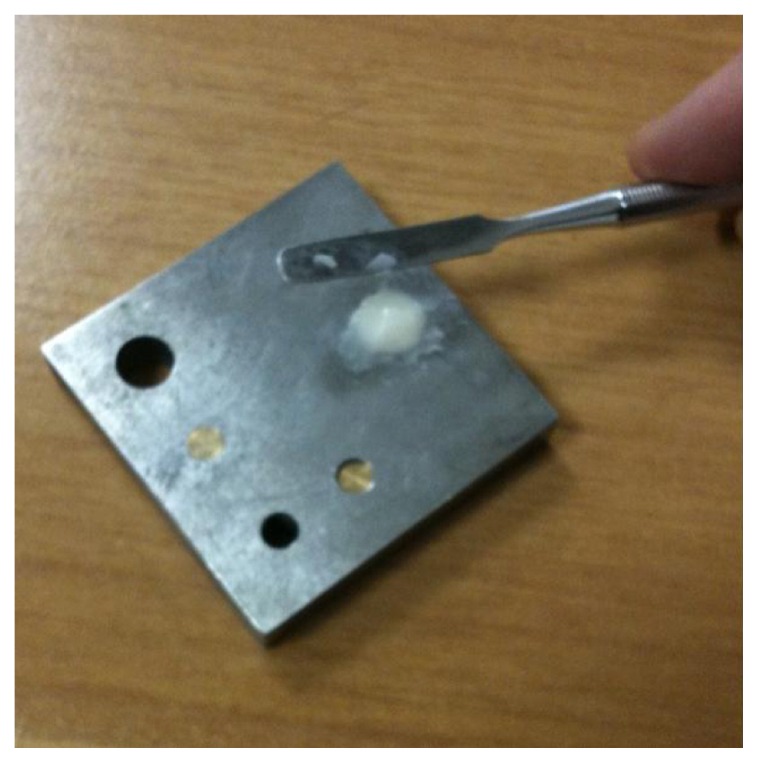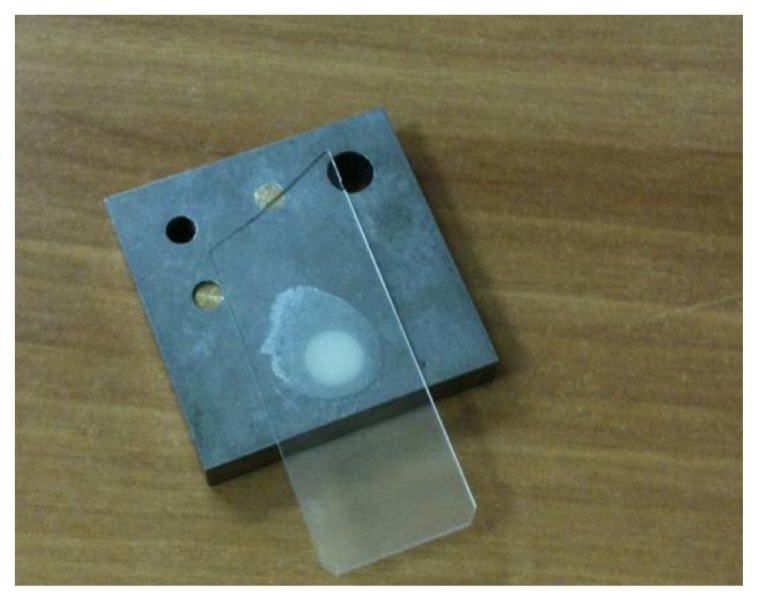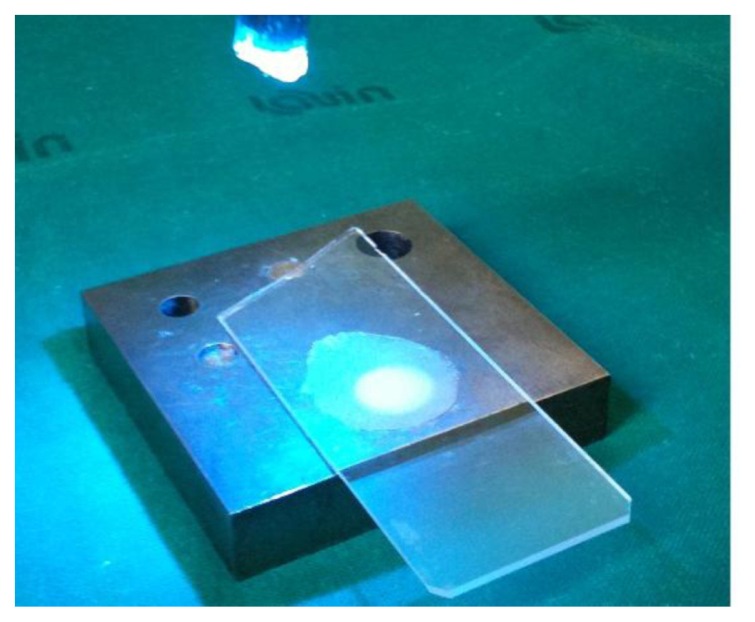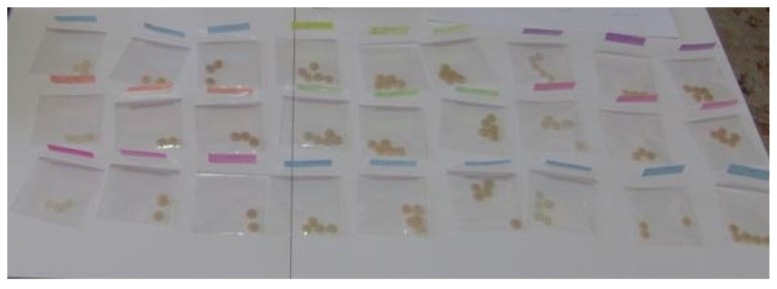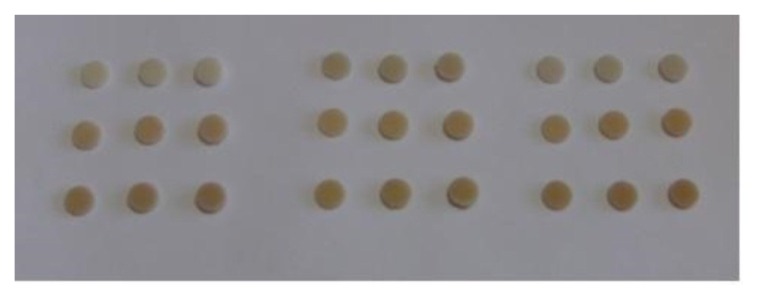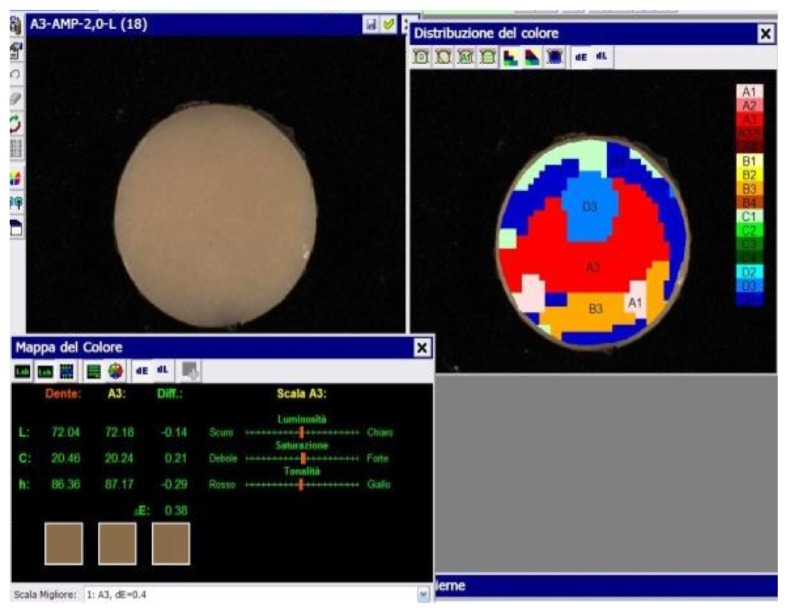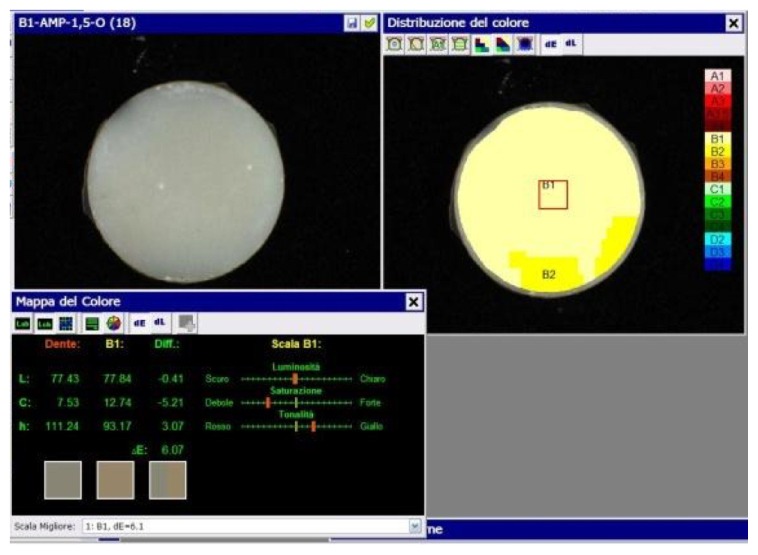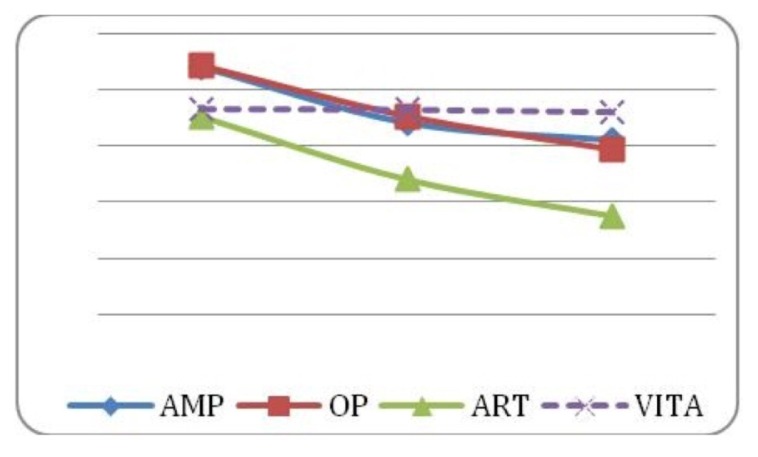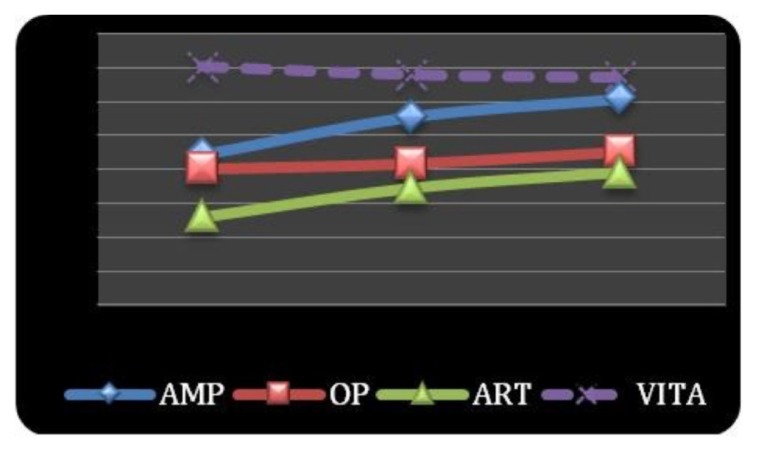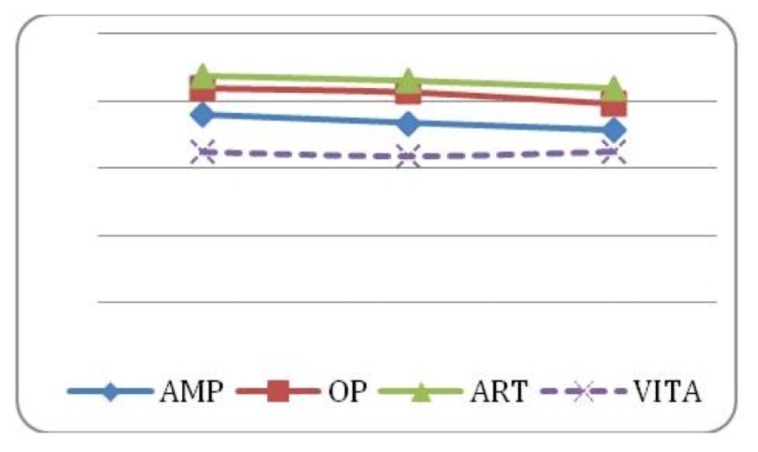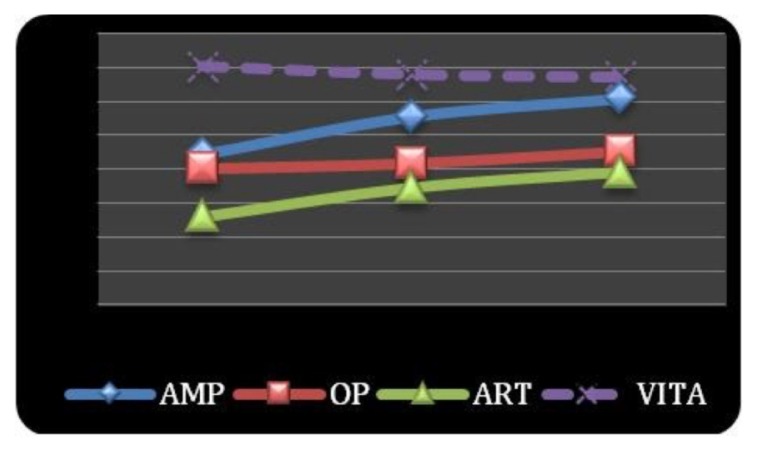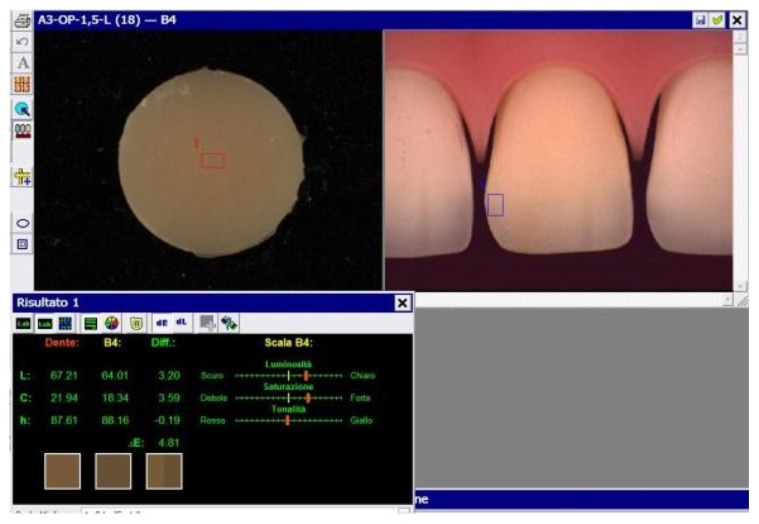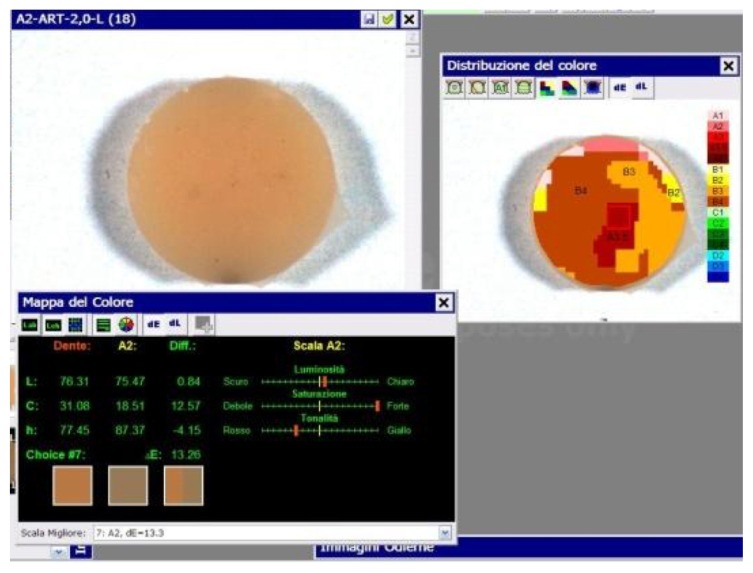Summary
The purpose of this study was to investigate the color samples (A2, A3 and B1) of three different brands of resin composites using dentine masses. 135 discs were prepared (5 plates for each thickness, color and brand of composite material). A colorimetric evaluation, using white and black background, was performed just after preparation. The color was measured corresponding to “Vita” scale and ΔL, Δa, Δb and ΔE values were calculated using a spectrophotometer. The results showed that Value, Chroma and Hue often differ even if the same commercial color and same thickness is used. In conclusion, this study showed that the perfect aesthetics restoration is possible combining individual abilities, experience and correct techniques.
Keywords: composite, color, aesthetic restoration
Introduction
Resin composite is the material of choice used in direct restorations, as it offers an aesthetic, conservative, durable and economic treatment solution (1). The major requirement of composite resin is the ability to achieve an excellent color matching with the natural teeth and the maintenance of the optical properties over time. The goals for aesthetic dental restorations are to obtain morphologic, optical, and biologic result miming natural enamel and dentine. This color matching is performed in order to obtain harmony with the surrounding anatomical structures.
Literature shows many analysis in fields like facial aesthetic parameters (2), the influence of dental treatments on smile and of their proper relationship between function and aesthetic (3), the color properties of dental tissues (4) and (5) restorative materials and the effectiveness of methods for assessing the color (6, 7).
Our study focuses on the main element of restorative treatment: the composite resin.
The industry provides the operator with a wide range of composite resins to reproduce a certain color of Vita reference scale (8–10); for this reason, we tried to answer to the following question: can these materials really provide the desired color?
Thus, we compared three different brands of composite resin and, using a spectrophotometer, analyzing three basic parameters: Value, Chroma and Hue (11).
Materials and methods
Three different resin composites with dentine masses, colors A2, A3 and B1 were selected for in vitro study: Opallis (Isasan® srl, Italy), Artist (Pentron Clinical ®, USA) and Amelogen plus (Ultradent Products ®, Inc, USA). The choice to work only with dentin was dictated by the difficulty to overlap enamel and dentine known thickness plates, without the risk of distorting the final chromatic results. Furthermore, it is known that the readings provided by the spectrometer are greatly influenced by small air bubbles and discontinuities in the composite mass (12). This can deflect the light emitted from the spectrometer distorting the size and direction of the reflected light causing errors in numerical results (13). It was therefore necessary to realize discs with very smooth and polished surface, a condition difficult to satisfy. A metal matrix was then used for the realization of composite platelets (discs), 1 cm thick and bearing along its entire thickness holes of 1 mm diameter.
Metallic cylinders of 1 mm in diameter and height ranging from 5 mm to 9 mm. For each hole fits closely for each hole (Fig. 1). It was possible, by including several cylinders within the array, to modify the remaining thickness of the matrix, obtaining known thickness (ex. if we introduce a 8 mm cylinder high in the 1 cm deep hole, the final depth will be 2 mm). Thus, we used 1.5 mm, 2 mm and 2.5 mm thickness, using 7.5 mm, 8 mm and 8.5 mm height cylinders.
Figure 1.
Materials: metal matrix, metallic cylinders, a spatula and glass plate.
Each cylinder was inserted into the hole of the array using a common hammer, adapting the two metal parts to each other.
Furthermore, in the remaining depth of the hole of the matrix, composite was applied enough to fill the hole. This procedure was made using a composite spatula and in a single mass, in order to limit the possibility of air bubbles incorporation, resulting from the manual stratification of several layers (Fig. 2).
Figure 2.
The material was applied in the cylinder in the remaining depth.
Composite was then compressed against the cylinder by using a microscope slide (Thermo Scientific®, U.S.A.); a circular motion was imposed to the slide with constant pressure to remove air bubbles. With this technique, the exceeding material is displaced laterally, causing only minimum increases in thickness (in the range of one tenth of a millimeter). The contact between glass plate and composite generates a disc with smooth and glossy surface, suitable for subsequent spectrophotometric analysis (Fig. 3).
Figure 3.
Glass plate application over the cylindrical metal matrix with exceeding material.
Microscope slide allowed, due to its transparency, to the subsequent polymerization of the material by a halogen curing lamp (Elipar, 3M ESPE®) (Fig. 4).
Figure 4.
The material was light-cured with a halogen lamp.
After polymerization, the slide was then carefully separated from the plate and matrix, in order to minimize the distortion of the disc surface and the development of any microscopic defects that could skew the final results. Despite these precautions, however, has not been possible to avoid the separation of small fragments from composite plate margins. However, this does not affect the results of the experiment. This because the spectrophotometer was able to zoom the object examined and allows to select a precise spot for color analysis, avoiding areas of defects even when not visible at lower magnification.
After removing the slide with a blunt screw placed in contact with the rear surface of the cylinder and with the help of the hammer, the cylinder was slid through the hole and the plate was separated from its support. Those procedures may in some cases crack the edges of the plate without influencing, as seen before, the final analysis.
Thus, 5 plates for each thickness and for each color of each different brand of composite material were made. 135 plates were obtained, 45 was made with Opallis, 45 with Artiste and another 45 with Amelogen Plus. From this pool of 45 plates, 5 were A2 to 1.5 mm, 5 A2 2 mm, 5 A2 to 2.5 mm, 5 A3 of 1.5 mm, 5 A3 of 2 mm, 5 A3 of 2.5 mm, 5 B1 of 1.5 mm, 5 B1 of 2 mm and 5 B1 of 2.5 mm (Fig. 5).
Figure 5.
135 plates, 45 of which are made with Opallis, 45 with Artiste and 45 with Amelogen Plus.
The discs, grouped, packaged and labeled, were then sent to a professional technician who has selected the chip that has lower defects from this pool of 5 for providing numerical data. This analysis was conducted using spectrophotometer (Spectro Shade Micro, MHT, Italy).
It is important to underline that, with the help of a double and symmetrical light source, the results given by the equipment are in no way influenced by other sources of light.
After calibration, the instrument was placed on a suitable support to ensure that the angle between light beam and the surface of the discs remain constant (the Spectro Shade Micro was positioned with a 90° angle from the disc in order to generate an angle of 45° between the two light beams and the disc itself), then two digital images for each plate were made: the first on a black background (oral cavity), the other on a white background (tooth) (Figs. 6, 7).
Figure 6.
Discs performed over black background.
Figure 7.
Discs performed over white background.
Each image is composed as follows: a zoomed picture of the disc is showed on the left side, on the right its color distribution and below a table. This table includes, from left to right, the details of Value, Chroma and Hue (or Value, quantity of red and yellow), the Vita scale for that color and thickness, and their numerical difference; on the right side there is a graphical representation of this numerical difference; on the lower side ΔE is showed (ΔE = √ [(ΔL *) 2 + (Δa *) 2 + (Δb *) 2]), expressing in mathematical terms how much the overall color of the disc differs from its corresponding Vita scale; beneath the ΔE are represented visually, from left to right, the color of the disc, that corresponding Vita, and finally the two colors are represented side by side in order to reveal any differences (Fig. 8).
Figure 8.
The disc color difference according Vita scale.
Results and discussion
Numerical values were then extrapolated from each image and reorganized into three Tables. Table 1 shows the analysis of 1.5 mm thickness composite discs. Table 2 shows data on the 2 mm thickness discs. Table 3 shows 2.5 mm thickness.
Table 1.
The analysis of composite discs 1.5 mm thickness.
| L | C | H | ||||||||||
|---|---|---|---|---|---|---|---|---|---|---|---|---|
|
| ||||||||||||
| Composite | Background | Color | ΔE | |||||||||
|
| ||||||||||||
| Tooth | Vita | Diff. | Tooth | Vita | Diff. | Tooth | Vita | Diff. | ||||
| Amelogen Plus | White | A3 | 74,82 | 73,28 | 1,54 | 27,89 | 22,78 | 5,1 | 76,84 | 85,98 | −4,02 | 6,68 |
| A2 | 76,42 | 75,6 | 0,82 | 27,41 | 18,87 | 8,54 | 80,04 | 87,92 | 3,12 | 9,13 | ||
| B1 | 86,3 | 77,76 | 8,54 | 16,6 | 12,77 | 3,84 | 96,61 | 92,64 | 1,01 | 9,41 | ||
| Black | A3 | 69,03 | 72,98 | −3,95 | 19,5 | 21,15 | −1,64 | 84,71 | 84,63 | 0,03 | 4,34 | |
| A2 | 70,86 | 75,98 | −5,11 | 18,66 | 19,59 | −0,93 | 91,32 | 85,99 | 1,78 | 5,49 | ||
| B1 | 77,43 | 77,84 | −0,41 | 7,53 | 12,74 | −5,21 | 111,24 | 93,17 | 3,07 | 6,07 | ||
| Opallis | White | A3 | 74,9 | 73,36 | 1,54 | 31,95 | 22,48 | 9,47 | 79,93 | 85,83 | −2,76 | 9,99 |
| A2 | 78,21 | 75,84 | 2,37 | 31,18 | 19,2 | 11,98 | 80,27 | 87,02 | −2,88 | 12,55 | ||
| B1 | 77,96 | 77,88 | −0,25 | 23,89 | 13 | 10,89 | 84,65 | 92,55 | −2,43 | 11,16 | ||
| Black | A3 | 67,03 | 72,41 | −5,38 | 22,57 | 21,9 | 0,67 | 86,76 | 84,89 | 0,72 | 5,47 | |
| A2 | 70,04 | 75,96 | −5,92 | 20,36 | 19,56 | 0,79 | 89,68 | 85,96 | 1,3 | 6,12 | ||
| B1 | 67,83 | 76,66 | −8,83 | 12,2 | 13,74 | −1,54 | 101,36 | 93,79 | 1,71 | 9,12 | ||
| Artiste | White | A3 | 73,02 | 73,33 | −0,31 | 33,67 | 21,93 | 11,74 | 77,52 | 85,8 | −3,92 | 12,38 |
| A2 | 77,17 | 75,77 | 1,39 | 31,11 | 18,94 | 12,17 | 79,92 | 86,69 | −2,86 | 12,58 | ||
| B1 | 82,52 | 78,28 | 4,24 | 18,53 | 13,54 | 4,99 | 88,54 | 92,18 | −1 | 6,63 | ||
| Black | A3 | 63,25 | 72,64 | −9,39 | 21,74 | 22,8 | −1,06 | 84,31 | 84,62 | 0,12 | 9,45 | |
| A2 | 67,19 | 76,27 | −9,08 | 18,88 | 19 | −0,11 | 85,26 | 87,41 | −0,71 | 9,11 | ||
| B1 | 77,19 | 77,52 | −0,33 | 13,31 | 13,31 | 0 | 97,17 | 94,15 | 0,49 | 0,59 | ||
Table 2.
The analysis of composite discs of 2 mm thickness.
| L | C | H | ||||||||||
|---|---|---|---|---|---|---|---|---|---|---|---|---|
|
| ||||||||||||
| Composite | Background | Color | ΔE | |||||||||
|
| ||||||||||||
| Tooth | Vita | Diff. | Tooth | Vita | Diff. | Tooth | Vita | Diff. | ||||
| Amelogen Plus | White | A3 | 72,84 | 73,46 | −0,62 | 26,72 | 21,94 | 4,78 | 76,21 | 86,35 | −4,28 | 6,45 |
| A2 | 78,31 | 75,99 | 2,32 | 26,92 | 19,28 | 7,64 | 78,75 | 87,63 | −3,53 | 8,73 | ||
| B1 | 84,5 | 77,8 | 6,7 | 18,29 | 13,42 | 4,87 | 94,62 | 92,73 | 0,52 | 8,3 | ||
| Black | A3 | 72,04 | 72,18 | −0,14 | 20,46 | 20,24 | 0,21 | 85,36 | 86,17 | 0,29 | 0,38 | |
| A2 | 73,11 | 75,95 | −2,84 | 19,26 | 19,23 | 0,03 | 88,02 | 86,52 | 0,5 | 2,88 | ||
| B1 | 80,05 | 78,27 | 1,78 | 9,53 | 13,47 | −3,94 | 110,16 | 92,25 | 3,53 | 5,58 | ||
| Opallis | White | A3 | 73,07 | 73,37 | −0,3 | 31,32 | 21,7 | 9,63 | 78,79 | 85,81 | −3,19 | 10,15 |
| A2 | 77,13 | 75,83 | 1,03 | 30,75 | 18,89 | 11,86 | 78,66 | 87,51 | −3,72 | 12,5 | ||
| B1 | 75,64 | 77,78 | −2,14 | 22,12 | 12,73 | 9,39 | 82,62 | 91,81 | −2,69 | 10 | ||
| Black | A3 | 67,04 | 72,92 | −5,89 | 22,72 | 21,17 | 1,55 | 86,01 | 85,98 | 0,01 | 6,09 | |
| A2 | 70,36 | 74,86 | −4,51 | 20,92 | 17,81 | 3,12 | 87,51 | 88,18 | −0,22 | 5,48 | ||
| B1 | 70,66 | 77,66 | −6,97 | 19,47 | 13,58 | 5,89 | 97,1 | 88,74 | 2,37 | 9,43 | ||
| Artiste | White | A3 | 70,81 | 73,07 | −2,26 | 33,03 | 21,39 | 11,64 | 75,75 | 86,52 | −4,99 | 12,87 |
| A2 | 76,31 | 75,47 | 0,84 | 31,08 | 18,51 | 12,57 | 77,45 | 87,37 | −4,15 | 13,26 | ||
| B1 | 81,28 | 78,37 | 2,91 | 19,21 | 13,03 | 6,17 | 87,45 | 90,83 | −0,93 | 6,89 | ||
| Black | A3 | 63,81 | 73,16 | −9,35 | 23,63 | 22,54 | 1,09 | 82,39 | 83,61 | −0,49 | 9,42 | |
| A2 | 68,89 | 76,05 | −7,16 | 21,82 | 19,57 | 2,24 | 84,38 | 86,67 | −0,82 | 7,55 | ||
| B1 | 77,94 | 78,31 | −1,37 | 12,11 | 12,05 | 0,05 | 95,53 | 93,64 | 0,4 | 1,43 | ||
Table 3.
The analysis of composite discs of 2.5 mm thickness.
| L | C | H | ||||||||||
|---|---|---|---|---|---|---|---|---|---|---|---|---|
|
| ||||||||||||
| Composite | Background | Color | ΔE | |||||||||
|
| ||||||||||||
| Tooth | Vita | Diff. | Tooth | Vita | Diff. | Tooth | Vita | Diff. | ||||
| Amelogen Plus | White | A3 | 72,22 | 73,07 | −0,85 | 25,65 | 23,03 | 2,62 | 76,23 | 84,38 | 3,45 | 4,42 |
| A2 | 77,82 | 74,74 | 3,08 | 26,55 | 17,86 | 8,69 | 78,77 | 87,96 | −3,49 | 9,86 | ||
| B1 | 85,25 | 78,16 | 7,09 | 18,1 | 13,29 | 4,81 | 94,27 | 89,26 | 1,36 | 8,68 | ||
| Black | A3 | 69,31 | 72,88 | −3,57 | 21,62 | 21,25 | 0,37 | 83,36 | 85,59 | −0,84 | 3,68 | |
| A2 | 74,18 | 75,97 | −1,78 | 20,73 | 20,1 | 0,63 | 86,96 | 86,53 | 0,15 | 1,9 | ||
| B1 | 79,6 | 77,99 | 1,61 | 11,71 | 13,03 | −1,32 | 104,83 | 92,46 | 2,66 | 3,38 | ||
| Opallis | White | A3 | 71,87 | 73,23 | −1,37 | 29,54 | 22,47 | 7,07 | 78,12 | 83,98 | −2,63 | 7,66 |
| A2 | 75,89 | 76,21 | −0,33 | 28,92 | 18,84 | 10,08 | 77,33 | 87,35 | −4,07 | 10,88 | ||
| B1 | 74,99 | 77,86 | −2,88 | 22,61 | 12,79 | 9,81 | 83,93 | 93,19 | −2,75 | 10,59 | ||
| Black | A3 | 68,32 | 72,99 | −4,67 | 23,78 | 20,93 | −2,84 | 85,34 | 86,15 | 0,32 | 5,48 | |
| A2 | 71,07 | 74,46 | −3,39 | 21,69 | 18,65 | 3,04 | 85,28 | 88,01 | 0,96 | 4,65 | ||
| B1 | 70,03 | 78 | −7,98 | 15,67 | 12,92 | 2,75 | 90,59 | 91,77 | −0,29 | 8,44 | ||
| Artiste | White | A3 | 69,52 | 73,38 | −3,86 | 31,97 | 21,82 | 10,15 | 73,96 | 85,97 | −5,53 | 12,19 |
| A2 | 76,08 | 75,98 | 0,1 | 32,1 | 19,07 | 13,03 | 75,96 | 87,23 | −4,86 | 13,91 | ||
| B1 | 80,83 | 77,99 | 2,84 | 18,86 | 13,53 | 5,34 | 84,98 | 91,52 | −1,82 | 6,31 | ||
| Black | A3 | 63,44 | 72,98 | −9,53 | 23,25 | 20,95 | 2,3 | 78,29 | 86,09 | −3 | 10,26 | |
| A2 | 69.81 | 75,99 | −6,19 | 23,03 | 18,48 | 4,45 | 83,44 | 86,6 | −1,14 | 7,76 | ||
| B1 | 75,43 | 77,95 | −2,52 | 13,07 | 12,98 | 0,09 | 92,19 | 92,38 | −0,04 | 2,52 | ||
In each Table are shown from left to right, the name of the composite used; the color of the background used; the color printed on composite tubes; the Value of the disc of the corresponding Vita scale and their difference; the Chroma of the disc of the corresponding Vita scale and their difference, the Hue of the disc of the corresponding Vita scale and their difference; the ΔE.
Before examining the numerical data, is important to focus directly on the images obtained by the computer software. In most cases there is an uneven distribution of the material used (Fig. 8); only Amelogen Plus in color B1 (Fig. 9) has an approximately uniform color map. This issue is due in part to the manual layering and partly to excessive viscosity of the material. It is interesting to note that background greatly influence the color of the composite disc. The white background, that simulate dentin (miming vestibular tooth face restoration at 1/3 cervical), reflects all the incident light; the black background simulate a restoration with the oral cavity as background (for example fractured incisal angles restoration), will absorb all the light directed on it. These differences in absorption would certainly influence the overall color of the restoration in terms of Value and Chroma, which would be much higher if the composite is placed on a white background rather than on a black one. Contrariwise, Hue increase on black background if compared to white.
Figure 9.
Amelogen Plus (B1) uniform color map.
It is important to observe that white and black represent only two extremes of colors that can be found as background during restorations in the oral cavity.
Value
Analyzing the results for what concerns the Value of the composite (L) we can see that, on a white background (7 samples out of 9) normally L decreases with increasing thickness (Fig. 10); this shows that increasing the thickness and thus the opacity, composite is less influenced by the background which enhances its Value making it brighter. Only in 2 samples this is not shown (Amelogen A2-B1). However, A2 plate with 1.5 mm thickness and B1 of 2.5 mm, displays surface defects that may have influenced spectrophotometer analysis due to limitations in the manual technique, even if standardized, and to the excessive viscosity of the material.
Figure 10.
Value decreases with increasing thickness over a white background.
On a black background L is significantly reduced if compared with white background; this because black absorbs and reflects light, appearing darker to an observer.
Furthermore, the samples of 1.5 mm thickness are always the darkest (except for Artiste B1, where the 2.5 mm sample is the darkest, probably due to an error during stratification), while 2 mm and 2.5 mm samples, present in most cases (6 times out of 9) small differences in Value that are imperceptible to seen (Fig. 11); clinical trials have shown that the human eye cannot distinguish ΔL of −1 <x> 1. A trained and experienced eye can refers ΔL of −0.05 <x> 0.05. This data shows a substantial difference in L value between composites with same color and thickness but from different manufacturer: the Amelogen B1 is brighter than B1 from other 2 brands.
Figure 11.
Value is significantly reduced over a black background.
Regarding ΔL on a white background, we noticed that 10 samples out of 27 show good correspondence with Vita scale (difference −1 <x> 1), 12 are brighter and 5 darker than baseline color. Analyzing each manufacturer we observe that AMP, for example, in A3 2 mm and 2.5 mm cover well the background and has a good correspondence with Vita scale; with 1.5 mm thickness is strongly influenced by the background and appear brighter. Contrariwise AMP A2 is influenced from the background, showing an acceptable ΔL at 1.5 mm, but appears too bright in 2 mm and 2.5 mm thickness. This inconstant chromatic behavior with different thickness could be explained by the defects during stratification mentioned above. AMP B1 is always very bright with white background at all thickness.
Opallis (OP) A3 at 1.5 mm and 2 mm thickness, shows higher ΔL than Vita, but at 2.5 mm it is no longer influenced by the underlying background, appearing darker. OP A2 behaves as OP A3, showing an acceptable Value matching even at 2.5 mm. OP B1 displays acceptable ΔL at 1.5 mm, but appears darker at 2 mm and 2.5 mm.
Artiste (ART) A3 shows same behavior like OP B1 in terms of ΔL. ART A2 is very bright to 1.5 mm, whereas at 2 mm and 2.5 mm displays correct ΔL. ART B1 is always too bright. Regarding ΔL on a black background, we noticed that only 3 samples out of 27 show good correspondence with Vita scale (difference −1 <x> 1), 22 are Darker and 2 brighter than baseline color. AMP A3 is too dark except at 2 mm, where matches perfectly. AMP A2 is always too dark even if, increasing the thickness, the background has lesser influence in ΔL. AMP B1 at 1.5 mm, appears very similar to Vita scale; at 2 mm and 2.5 mm, covering the background, shows an increase in ΔL. The OP, already perceived dark as we have seen on white background, shows low Value; we noticed the same effects for ART A3 and A2. ART B1 at 1.5 mm thickness, result to be similar in L to Vita scale, whereas at 2 mm and 2.5 mm, covering black background, it is obviously brighter.
Croma
On a white background we observed that Croma (C) decrease with increasing thickness, This occurs because, reducing thickness, the composite is more influenced by the background that reflects light, causing an increasing in saturation (Fig. 12).
Figure 12.
Chroma tends to decrease over the white background.
This behavior is followed by 5 samples out of 9. In other cases the differences between discs regarding Croma, are almost imperceptible; clinical studies have shown that a ΔC of −3 <x> 3 is not distinguishable to the untrained human eye. Furthermore, in 7 samples out of 9, the thinner ones reveal more intense color.
On a black background C is greatly reduced; this because black background absorbs light, and therefore the color. Consequently, the saturation is reduced too. Normally, C value should increase with the thickness, being the samples less influenced by the background. This happens for 6 samples out of 9; in the remaining 3, 2 of them have subtle differences. The other 1, OP B1 and 2 mm thickness, differs from the previous due to some small surface defects that could modify C value (Fig. 13).
Figure 13.
Chroma increases with the thickness over black background.
By an examination of values showed in Tables 1–3 we can assess that for the same commercial color and thickness, the three different brands of composite show different characteristics regarding Croma.
Analyzing the values of ΔC expressed by the composites on the white background, we noted that 26 samples out of 27 show an excess in saturation than the Vita scale. Only one disc displays C values that match the corresponding Vita (AMP A3 2.5 mm thickness).
Examining ΔC we noted that in 21 samples out of 27 the black background reduce the C value so as to bring them near to Vita scale baseline; 4 samples shows a too much intense color whereas the remaining 2 appears above board.
Focusing on each composite manufacturer we noted that AMP A3 shows C slightly weaker at 1.5 mm (influenced by the black background), but is almost perfect at 2 mm and 2.5 mm. AMP A2 is always superimposed on Vita scale. AMP B1 at 1.5 mm has low C value, it is also above board at 2 mm, whereas at 2.5 mm covers the black background showing a C corresponding to Vita scale. Furthermore OP A3 1.5 mm, attenuated by the background, matches color perfectly. At greater thickness, Croma differs from Vita, but remains appropriate. OP A2 at 1.5 mm is acceptable, slightly intense at 2 mm and 2.5 mm (less influenced by the fund). OP B1 presents low ΔC to 1.5 mm, is more intense at 2.5 mm, whereas at 2 mm has high C value due to small imperfections (as mentioned before). ART A3 has a C superimposed to Vita scale on black background for all samples. ART A2 has a low ΔC at 1.5 mm but too saturated at 2 mm and 2.5 mm. ART B1 is almost perfect in terms of ΔC for all samples.
Hue
The third and last parameter that defines the color of our samples is the hue (H). Observing the values of H taken from discs lying on a white and a black background, it is not difficult to understand how this approach can influence our color perception: clinical trials show that the vast majority of the population is unable to perceive ΔH of −5 <x> 5.
The Hue is an intrinsic component of the material generally well represented. Just in one case H deviates significantly from the Vita value, showing a slight tendency to red; note also that there is a good correspondence between the discs of same thickness and color and of different manufacturer. Thus, H, compared to L and C is less influenced by the background color.
Conclusions
Identification of color is the first issue to deal with. The picture provided by the spectrometer, shows how the tooth color is far from being homogeneous.
Furthermore this color map can be used for aesthetics reconstruction of the anterior sector (Fig. 14).
Figure 14.
The tool shows numerical and visual feedback of color variations.
The second issue is choosing the most suitable composite for restoration. A solution should be using a brighter dentin if we working with a single mass, or to superimpose a white enamel if we work on two masses. Regarding Croma, however, the most composit examined shows an excessive color intensity: even in this case will be sufficient to use a dentin of aboveboard color or to superimpose an enamel that would mitigate the C. Generally, the Hue is not a problem, because is not able to modify the general chromatic effect (14).
A third issue comes from problems in the layering technique. The study shows how, almost in whole samples, the color distribution is not uniform. In fact the computer images show a patchy color map, underlining how the color differs from what we expect (Fig. 15).
Figure 15.
The spectrophotometer color analysis shows that color is not uniform.
Composites from different brands can be slightly brighter or darker when compared, slightly more or less opaque than the underlying background, more or less intense in color, but generally show similar behavior when used during clinical practice. Thus, it is important to choose the correct composite in relation to the background used and be able to recognize when to apply a different composite layers, enamel or dentin, in order to adjust effects or excesses in L and/or C values. We also emphasize that, even in this case, spectrophotometry can meet the needs of the neophyte, guiding the management of any adjustments in color choosing.
In conclusion, we can assess that, although the most recent restoration materials offer a greater range of colors, although the color properties of these materials are similar to the dental tissues, as our study shows, the realization of a perfect aesthetic restoration is possible only where a certain individual manual dexterity joins the experience and acquisition of appropriate technique.
References
- 1.Morley J. The role of cosmetic dentistry in restoring a youthful appearance. J Am Dent Assoc. 1999 Aug;130(8):1166–72. doi: 10.14219/jada.archive.1999.0370. Review. [DOI] [PubMed] [Google Scholar]
- 2.Sarver D, Jacobson RS. The aesthetic dentofacial analysis. Clin Plast Surg. 2007 Jul;34(3):369–94. doi: 10.1016/j.cps.2007.05.008. Review. [DOI] [PubMed] [Google Scholar]
- 3.Dietschi D. Optimizing smile composition and esthetics with resin composites and other conservative esthetic procedures. Eur J Esthet Dent. 2008 Spring;3(1):14–29. [PubMed] [Google Scholar]
- 4.Yu B, Ahn JS, Lee YK. Measurement of translucency of tooth enamel and dentin. Acta Odontol Scand. 2009 Feb;67(1):57–64. doi: 10.1080/00016350802577818. [DOI] [PubMed] [Google Scholar]
- 5.Kim SJ, Son HH, Cho BH, Lee IB, Um CM. Translucency and masking ability of various opaque-shade composite resins. J Dent. 2009 Feb;37(2):102–7. doi: 10.1016/j.jdent.2008.10.002. Epub 2008 Nov 22. [DOI] [PubMed] [Google Scholar]
- 6.Kuzmanović D, Lyons KM. Tooth shade selection using a colorimetric instrument compared with that using a conventional shade guide. N Z Dent J. 2009 Dec;105(4):131–4. [PubMed] [Google Scholar]
- 7.Judeh A, Al-Wahadni A. A comparison between conventional visual and spectrophotometric methods for shade selection. Quintessence Int. 2009 Oct;40(9):e69–79. [PubMed] [Google Scholar]
- 8.Magne Bruzi G, Carvalho AO, Giannini M, Maia HP. Evaluation of an anatomic dual laminate composite resin shade guide. J Dent. 2013 Aug;41( Suppl 3):e80–6. doi: 10.1016/j.jdent.2013.05.001. [DOI] [PubMed] [Google Scholar]
- 9.Park SK, Lee YK. Shade distribution of commercial resin composites and color difference with shade guide tabs. Am J Dent. 2007 Oct;20(5):335–9. [PubMed] [Google Scholar]
- 10.Paravina RD, Kimura M, Powers JM. Color compatibility of resin composites of identical shade designation. Quintessence Int. 2006 Oct;37(9):713–9. [PubMed] [Google Scholar]
- 11.Ahn JS, Lee YK. Color distribution of a shade guide in the value, chroma, and hue scale. J Prosthet Dent. 2008 Jul;100( 1):18–28. doi: 10.1016/S0022-3913(08)60129-8. [DOI] [PubMed] [Google Scholar]
- 12.Chirdon WM, O’Brien WJ, Robertson RE. Mechanisms of goniochromism relevant to restorative dentistry. Dent Mater. 2009 Jun;25(6):802–9. doi: 10.1016/j.dental.2009.01.003. Epub 2009 Feb 8. [DOI] [PubMed] [Google Scholar]
- 13.Ferraris F, Diamantopoulou S, Acunzo R, Alcidi R. Influence of enamel composite thickness on value, chroma and translucency of a high and non high refractive index resin composite. Int J Esthet Dent. 2014 Fall;9(3):382–401. [PubMed] [Google Scholar]
- 14.Sikri Vimal K. Color: Implications in dentistry. J Conserv Dent. 2010 Oct-Dec;13(4):249–255. doi: 10.4103/0972-0707.73381. [DOI] [PMC free article] [PubMed] [Google Scholar]



